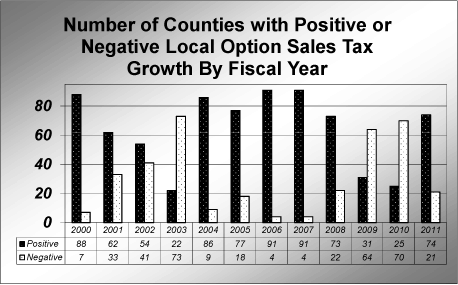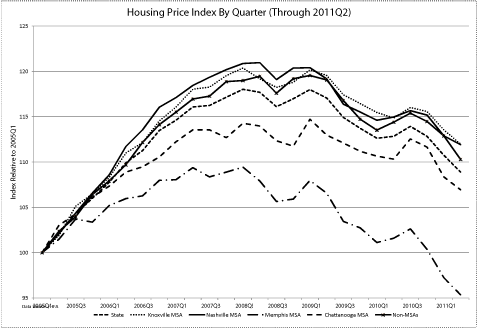The Residual Impact of the Recession on Local Government Taxes
by Stanley Chervin, PhD and Harry A. Green, PhD
The Residual Impact of the Recession on Local Government Taxes1
Local Sales Taxes
The residual impact of the economic recession continues to plague the finances of many local governments. While the recession formally ended in June 2009, its impact on sales tax collections—the second most important local tax source—lingers in many counties.2 While state sales tax collections increased 4.7% in fiscal year 2010-2011,3 and total local sales taxes (for the same period) increased by 4.1%, local sales tax collections in 21 counties were less than during the previous fiscal year.4

In addition to the disappointing growth in 21 counties during fiscal 2011, the actual level of sales tax collections for the state, as well as for many counties, remains below collection levels of four and five years ago. Fifty counties collected less in fiscal year 2011 than during fiscal year 2007 (collecting $65.6 million less). Twenty-four counties collected less in fiscal year 2011 than during fiscal year 2006 (collecting $27 million less).5
The largest declines during fiscal year 2011 relative to collections four years earlier in 2007 were experienced in Davidson County ($25.9 million less) and in Shelby County ($12.9 million less). Despite fiscal year growth in collections in Davidson, Hamilton, Knox, and Shelby Counties during 2011, all four are yet to reach collection levels of four years ago. Thus not only are many rural counties suffering from the lingering impact of the recession, but so are our four largest counties. They are all struggling to maintain basic service levels with sales tax revenue that in many cases is less than that received four and five years ago.
Local Property Taxes
The property tax remains the most important source of local tax revenue in all but one county (Sevier County). The impact of the recession and falling property values on property tax collections will depend directly on the delayed impact on assessments. Since falling residential and commercial and industrial market values have only a limited immediate impact on assessed values, much of the impact of falling property market values will appear during reappraisals. Housing prices in Tennessee peaked in late 2007 and during 2008 (see chart). Since values during a reappraisal are based on sales made during the previous year, many reappraisal notices received by Tennesseans in 2009 (that were based on sales in 2008) were probably a shock—given that by the time the reappraisal notices were received the housing market was already in decline.
The true litmus test of the impact of the housing value slump will first come when counties who last reappraised in 2008 and in 2009 (based respectively on sales in 2007 and 2008) reappraise in 2012 and 2013. Fortunately, no counties last reappraised in 2008 are on a four-year reappraisal cycle.6 Therefore, it will be 2013 before any county that reappraised during the price peak of the last housing boom is scheduled to reappraise again. The good news is that Tennessee for the most part avoided the catastrophic declines (over last 5 years) in property values seen in Arizona (-43%), California (-42%), Florida (-40%), and Nevada (-53%).7 During the next reappraisal cycle in these states, local officials will have to face either draconian cuts to local budgets, or significant increases in nominal tax rates.
The outlook for Tennessee local governments, while less challenging than in many other states, will still require historically new strategies to deal with the prospect of historically low increases in taxable assessments during the next reappraisal cycle. No longer will the reappraisal cycle provide local officials with a cakewalk in raising new local property tax revenue. Local property tax revenue has risen over time primarily as a result of growing property values (and therefore taxable assessments). This has in many cases allowed nominal property tax rates themselves to remain fairly stable over a long period of time.8
Conclusion
The combined effect of recent multi-year declines in local sales tax collections and the threat of required future property tax rate increases poses future funding problems for local governments. The availability of federal stimulus money and deliberate state funding decisions favoring K-12 education (at the expense of other state programs) helped stabilize K-12 spending over the last three years. However future K-12 program funding will be problematic.
Endnotes
1This report focuses only on the two primary tax sources used to finance local governments. In addition to sales tax and property tax problems discussed in this report, local governments will also be impacted by slowly recovering state shared tax revenue and the end of the federal stimulus program (ARRA).
2In Sevier County, local sales tax revenue exceeds property tax revenue.
3Compared to collections during July 2009-April 2010. Data from June 2011 issue of Tennessee Department of Revenue “Revenue Collections.”
4Mostly rural counties: Campbell, Carroll, Cheatham, Claiborne, DeKalb, Fentress, Grainger, Hardeman, Haywood, Jackson, Lauderdale, Lincoln, McNairy, Marshall, Meigs, Monroe, Moore, Scott, Union, Van Buren, and Wayne.
5During fiscal year 2011, state sales tax collections were only $5.5 million more than collections five years earlier (in fiscal year 2006). State sales tax data is adjusted for the reduction in the state sales tax rate on food (effective 1/1/2008).
6See schedule at https://comptroller.tn.gov/office-functions/pa/tax-resources/assessment-information-for-each-county/reappraisal-schedule.html.
7Source: Federal Housing Finance Agency.
8In fact, nominal property tax rates in 73 counties were less in 2010 than in 1999.
Updated August 2011
Supplemental Report - Evidence from Current County Reappraisals of the Impact of Recent Property Value Declines on Future Reappraisals and Taxable Assessments